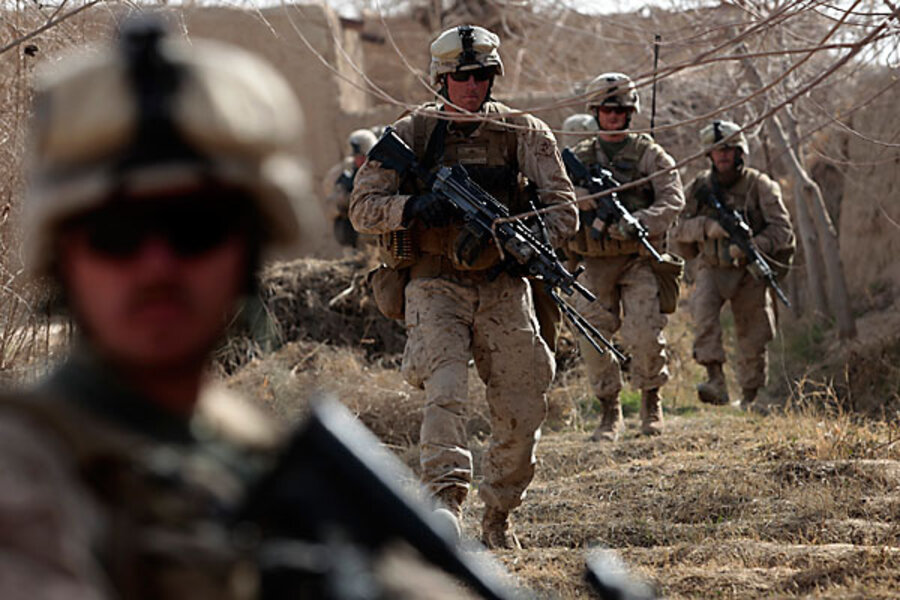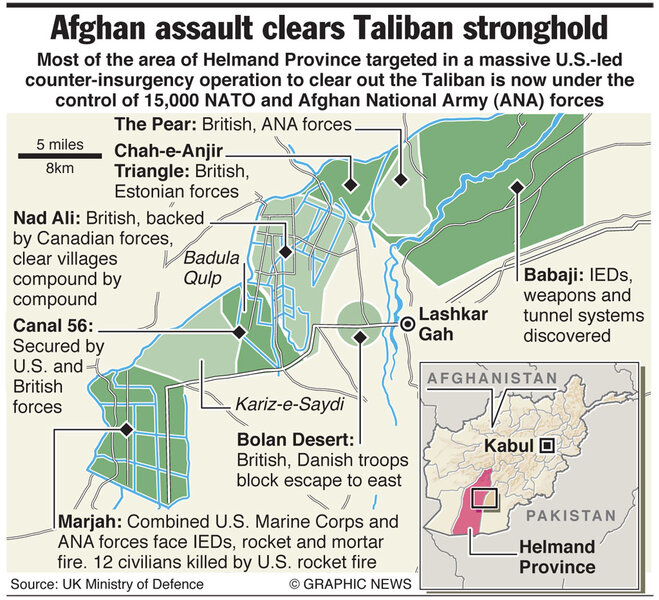In Marjah offensive, Afghan forces take the lead
| New Delhi
In a marked contrast from previous campaigns, Afghan forces outnumber international forces by a ratio of 3 to 2 in the Marjah offensive launched this weekend, according to US military officials.
Just this past summer, when 4,000 US Marines swept into towns south of Marjah along the Helmand River, they did so with only 650 Afghan national security forces. The 6-to-1 ratio frustrated US commanders and became emblematic of the lack of readiness of Afghan forces after eight years of international military assistance and training.
President Obama has made training Afghans a top priority so that US forces can begin drawing down later this year. The Afghan force numbers for Marjah – some 10 times larger than in the summer offensive – do not in themselves prove rapid advancements in recruitment and training. But it is a positive indicator that Afghan authorities could mobilize that large a force for a dangerous assault on one of the Taliban's main strongholds.
"It's a large number and that in itself says something about having a force that can engage in military combat," says Ayesha Khan, associate fellow at London-based Chatham House. But, she adds, it does not mean Afghan forces are anywhere close to taking over the fight. "I don't think Afghan forces ... are ready to clear, hold, build."
Gun battles rage
Gun battles continued Monday in Marjah, as Taliban snipers shot at marines and Afghan troops. One American and one Briton have died so far in the fighting, while Afghan officials claimed Sunday that as many as 35 militants had been killed in the first two days of the offensive.
Communications from the International Security Assistance Force (ISAF) have been inconsistent in the opening days of the offensive regarding force levels, and their numbers still differ somewhat from the information from Afghan ministries. Part of the confusion has to do with distinctions between combat troops and support troops, as well as the desire to remain vague for operational security.
The ISAF says that approximately 10,000 Afghan and international forces are fighting side-by-side in Operation Moshtarak, which means "Together." Of that force, roughly 60 percent are Afghan, 40 percent are international, according to the ISAF. Some 5,000 additional troops are supporting the assault.
The Ministry of Defense says that 5,000 Afghan National Army (ANA) soldiers are taking part. The Ministry of Interior spokesman Zmarai Bashari says that 1,800 police "will join after the military operation to do the law enforcement and security."
Ethnic issues
High desertion rates and an ethnic imbalance have hobbled Afghan security forces. Non-Pashtun minorities from safer parts of Afghanistan will often go through the training and promptly quit when assigned to more dangerous postings in the volatile Pashtun regions of southern and eastern Afghanistan.
As a result, Afghan authorities have been reluctant to send troops into those regions. It's one of the reasons why US Marines in Helmand have been reaching out aggressively to the local population to recruit and train Pashtuns for the Afghan forces.
Ministry of Defense spokesman Gen. Zahir Azimi declined to comment on why so few Afghan soldiers were sent for the summer offensive in Helmand known as Operation Khanjar, and why more troops were dispatched for the Marjah assault. Over the summer, the Afghan military was stretched thin trying to provide security around the country for the upcoming presidential elections.
An ISAF spokesman chalks up the greater Afghan involvement to the growing numbers and training of the ANA. "They've grown in capacity. They've been able to project capacity into areas they previously weren't able to purely because of capacity and numbers," says Lt. Col. Todd Breasseale.
Many of the Afghan forces actually come from outside Helmand, according to General Azimi. Just one kandak – or brigade – is from the southern corps; the remainder were repositioned from corps based in Kabul, Gardez, and Chugha-Serai. As for the police, 700 come from Helmand, the remaining 1,100 were sent from Kabul, Kandahar, and other provinces.
New willingness to fight on the front lines
On the one hand, this shows that nascent training efforts in Helmand have not yet produced a large battle-ready force. On the other hand, the repositioning of forces demonstrates a willingness of some Afghan units to be dispatched to frontline battles.
So far in the Marjah fight, Afghan security forces were among the troops airdropped behind enemy lines in the operation's opening gambit. Afghan forces also led one of the shuras – or meetings with locals – that commanders on the ground have been told to hold as soon as ground is cleared.
Involving Afghan troops on such operations pushes them up "the steep learning curve," says Ms. Khan. It also helps "Afghanize" the face of such a large assault force in a part of the country where some residents view international troops as occupiers. Khan notes that British and American casualties surged in the months following Operation Khanjar. Going in with more Afghan forces in the mix, she says, may minimize international troop fatalities and corresponding drops in public opinion in the US and Britain.
Back in July, Brig. Gen. Lawrence Nicholson, the commander of the Marines in Helmand, lamented how few Afghan forces could be mustered for Operation Khanjar. "I mean, I'm not going to sugarcoat it. The fact of the matter is, I – we don't have enough Afghan forces, and I'd like more," he said. "They're just not available right now."
He went on to explain why Afghan forces are crucial: "They are such force multipliers, because as you move through areas, they see things we'll never see. They understand intuitively what's going on in an area that we'll just never get, no matter how much cultural training our guys get. So they are absolutely essential."
While General Nicholson got better numbers this time around, the long-term success of the operation isn't a numbers game.
"Ultimately," Khan says, "the test will come in what transpires after this operation: Will it lead to ultimately an effective implementation of a counterinsurgency plan or not?"
Follow us on Twitter






